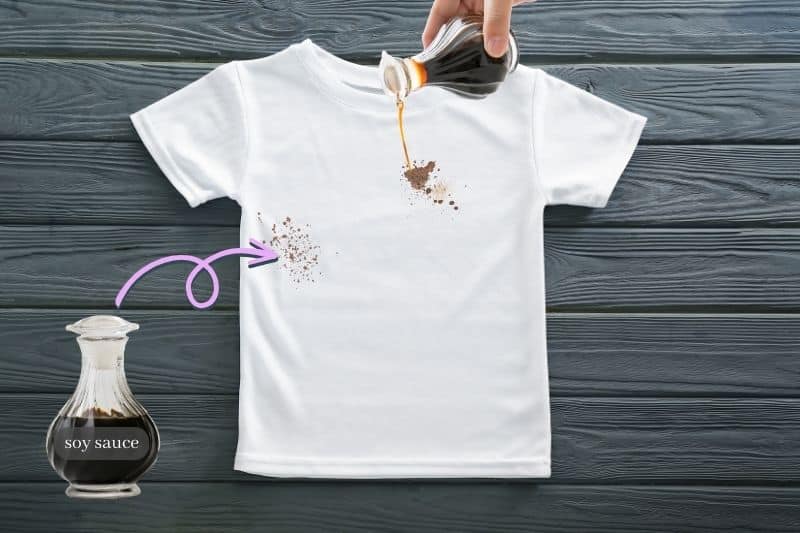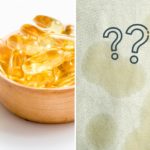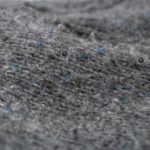Soy sauce. One of the tastiest condiments loved and used by chefs all over the world.
What savoury dish doesn’t dream of being blessed with the umami hit that only a slug of soy can deliver? But what garment doesn’t dread a splash of that very same sauce, all over its front?
Soy sauce, whether of the dark or light variety, can make a real mess, especially all over your chef’s whites.
But don’t despair. Don’t just sit there noodling. Follow these steps and you’ll takeaway all your problems.
Are Soy Sauce Stains Difficult to Get Out?
Yes and no. It’s all about how quickly you act. As you’ll see below, speed is of the essence. With the right action done at the right time, you’ll have it licked. So, chop chop (suey) is the name of the game.
What goes into soy sauce? It’s such a simple thing, usually made of only five ingredients: soybeans, wheat, water, salt and yeast. But it’s the fermentation that transforms it, that makes soy sauce more than the (dim) sum of its parts.
But why does soy sauce present such a threat? It’s all down to its colour. Unlike a lot of such shirt spoilers, soy sauce doesn’t contain oil so it’s not a grease-based terror. It’s just that rich brown colour: so welcome in food, so tedious on a sleeve.
How to Get Soy Sauce Out of Stains
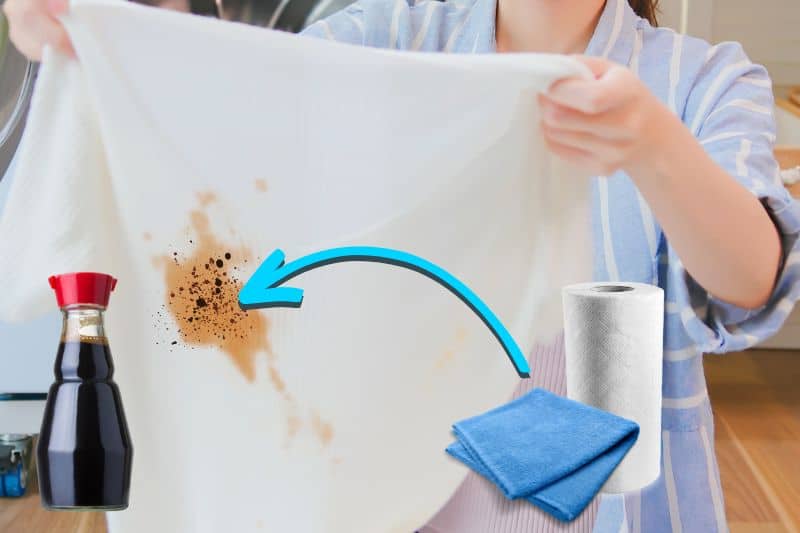
There are a number of options. Let’s start with two that you’ll find in the kitchen. The first one might even be kept in the same cupboard as that soya stainer.
Act quickly
Whichever method you use, you need to act quickly, so don’t think you can finish your Kung Pao first. Put down your chopsticks and get busy with cleaning.
Start by grabbing a dry cloth or paper towel, and blotting the excess, so that you’ve soaked up the sauce and stopped it from continuing on its stainy path.
Then get to the tap and rinse with cold water. If you can, try running the water from the inside of the garment out, in order to send the sauce back out from whence it came. No, not back into the bottle. Just out of the shirt.
Then, we’re on to one of the following methods.
Method 1: Vinegar
Yes, it’s our old friend Mr Uberclean himself. If there’s a more useful substance that does even more around the house than it does for the average chip’s taste appeal, I don’t know of it.
Vinegar’s the business, and that’s why, if you’ve got some, you should use it on your soyled (sorry) clothing.
As usual, white vinegar’s your best bet here.
Combine one part white vinegar with two parts water, and dunk a cloth in it. Then dab on liberally all over the stain.
Vinegar will do its miraculous thing pretty much straight away. Keep dabbing until you can see some pretty substantial action, then dab with pure water instead.
Method 2: Washing-up liquid
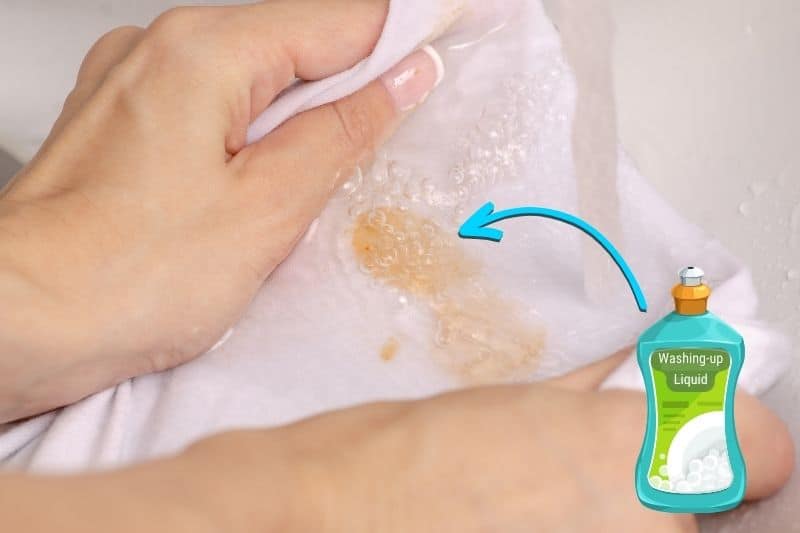
You can use washing-up liquid just the same as you’d use vinegar (i.e., use it in solution and dab onto the clothing until some action is perceived).
You can even use it after you’ve used the vinegar, if there’s still a stain to be removed. Just like with the vinegar, make sure you rinse with water afterwards.
Method 3: Laundry detergent
Get some liquid laundry detergent and give it a good rubbing directly into the stain, using your finger (or chopstick if you’re just in the zone).
Keep going until you can see some of the mark coming out. Then leave for five minutes. Eat a fortune cookie. Then rinse and repeat as necessary.
If there’s still a stain after all that, try applying it again, then popping in the washing machine.
No, you’re right: this isn’t a common option in most Chinese or Japanese restaurants, so probably best to wait until you get home.
Note: if it looks like nothing’s shifting that soy, then you might have to use a laundry stain remover, which is a heavier-duty customer altogether.
Just make sure you read the instructions, as not all fabrics will be entirely happy with the treatment they’ll receive from this butch powerhouse.
And while we’re talking butch…
Method 4: Bleach
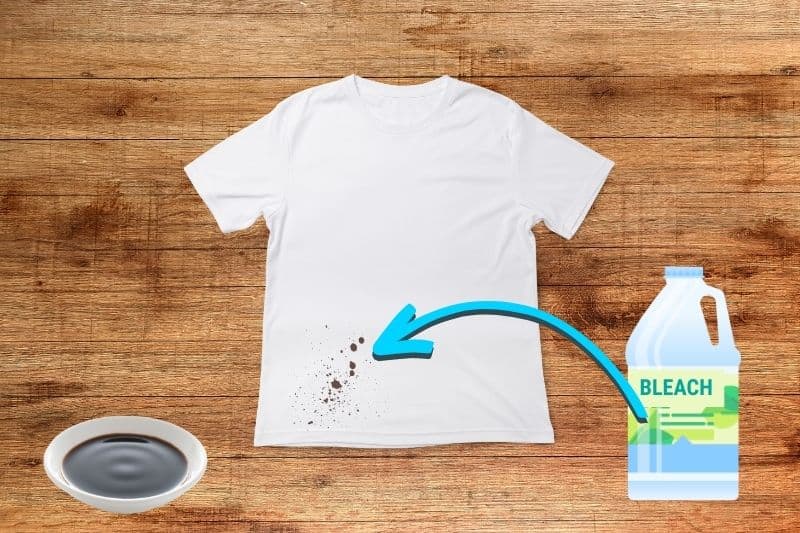
This is pretty much the nuclear option. Best to use oxygen bleach if you can—you can use it on most colours and it’s better for the planet too.
What you absolutely need to do is check the washing instructions to see if bleach is OK to use for that particular garment.
Then follow the instructions on the bleach container. Just be careful. Even oxygen bleach can be nasty stuff if it gets where it’s got no business being.
A similar substance you can use is hydrogen peroxide. Best to use it only on white clothing, as it does have a bleaching effect, as millions of punks and New Romantics will be only too happy to tell you.
Again, follow the instructions to the letter. And always test a small inconspicuous patch first.
Machine wash after treating the stain
Once you’ve gone down any of the routes above, get your garment in the wash as soon as you can.
Then, when the cycle’s finished, check to see if the stain is still there. If so, try washing it again.
On no account should you dry it with the stain still visible. What you’re doing there is making a good job of setting it, sealing that stain in for generations to come.
Worst case scenario? If that stain’s got its feet well and truly under the table, take it up with a dry cleaner.
Say ‘Sayonara’ to Soy Sauce
You’ve got a few solutions to soy stains there. As far as effectiveness goes, they’re all real (prawn) crackers. The most important thing you’ll be wonton to do is to act quickly so that soy will not annoy.
So, keep calm. Don’t lose your tempura. Follow these instructions without delay and your experience with soy sauce is sure to be sweet… and never sour.

Martin’s life revolves around films, dogs and food, but rarely all at the same time. At least two out of these three like to give clothes and furniture a hard time, and Martin enjoys discovering and writing about new ways to stop them doing their worst.
